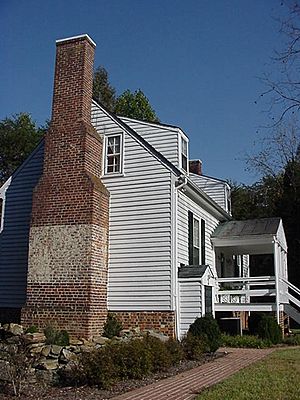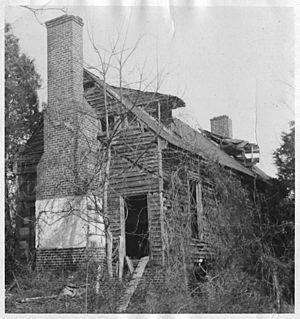Locust Grove (Dillwyn, Virginia) facts for kids
|
Peter Francisco House
|
|

Front of the house
|
|
| Location | SE of Dillwyn, 0.9 mi. S of SR 626, near Dillwyn, Virginia |
|---|---|
| Architectural style | Central-passage house |
| NRHP reference No. | 72001386 |
Quick facts for kids Significant dates |
|
| Added to NRHP | March 16, 1972 |
Locust Grove is a historic house located in Virginia, between the towns of Dillwyn and Cumberland. It was built before 1794. This house is special because of its connection to Peter Francisco, a brave soldier from the American Revolution. Because of this link, it is also known as the Peter Francisco House. It was added to the National Register of Historic Places on March 16, 1972.
About the House
Locust Grove is a one-and-a-half-story house. It has a pointed roof called a gable roof. There are two small windows that stick out from the roof on each side, known as dormers. The roof has a decorative edge called a box cornice.
The house has two chimneys, one at each end. The chimney on the east side is the original one, made with a special brick pattern called Flemish bond. The chimney on the west side was added later. It replaced an older one when a small wing was built onto the house. This wing is no longer there, but you can still see the foundation of its chimney. A small garden now grows where the wing used to be.
The main foundation of the house is made of bricks laid in an English bond pattern. The house also has a full basement. When the house was first nominated for the National Register, many of its original window frames and sills were still in place. Much of the original wooden siding, which had a special beaded design, also remained. The wood used for the house's structure is strong heart pine. It was put together using wooden pegs and nails.
Inside, the house had two main rooms on each floor. A central hallway held the stairs. Not many of the original inside parts are left. The decorative fireplace covers, called mantels, and the wooden panels on the lower walls, called wainscoting, were removed. Some floorboards from the second floor were also missing. Part of the first-floor had even fallen in. However, some parts of the stairway and the main door on the north side were still there. The walls were once covered in plaster, but much of it has worn away over time.
By the time Locust Grove was surveyed for the National Register of Historic Places, it was in very poor condition. It was even marked as "Deteriorated" on the official form. Most of the main wooden frame was still standing, showing how the house was built. But many of the inside and outside decorations were gone. In recent years, a lot of work has been done to fix up the house. Now, it is in good shape and can be lived in again.
Where it is Located
Locust Grove is found almost a mile off Virginia Route 626. It is close to the border between Buckingham County and Cumberland County. The house sits on farmland and undeveloped land at the end of a long dirt road. You approach the house from the north. The building itself is on the edge of a hill, looking out towards Payne Creek. It is quite far away from other buildings and towns.
When the house was first built, it was lined up with the Old Coach Road. This road used to connect Richmond and Appomattox. Scientists have found old parts of this roadbed not far from the property.
House History
We don't know much about the very early history of Locust Grove. It seems the house was built sometime before 1794. Peter Francisco moved into the house in that year and lived there until the mid-1820s. Some records suggest he might have moved in as early as 1785. Others think, based on the house's style, it was built between 1790 and 1810.
Peter Francisco had strong ties to the area. He grew up nearby at Hunting Towers. This was the estate of Judge Anthony Winston, who was the uncle of Patrick Henry, a famous American leader. We are not sure how Peter Francisco came to own the land where Locust Grove stands. Family stories say he received it from a local farmer named James Anderson. James Anderson was the father of Peter's first wife, Susannah.
Peter Francisco lived at Locust Grove with his second wife, Catherine Brooke. They raised four children together. Catherine passed away in 1821. Two years later, Peter married again. His third wife was a widowed niece of Governor Edmund Randolph. She convinced him to leave the countryside for a more comfortable life in Richmond. In Richmond, he worked as the Serjeant-at-Arms for the Senate of Virginia. He stayed in Richmond until he died.
Not many records from Peter Francisco's time at Locust Grove have survived. The few details we have suggest that his farm was typical for Virginia in the early 1800s. A tax record from 1815 shows that the household had horses and cattle. It also lists some household items. These included a mirror with a fancy gold frame, some cut glass goblets, and pictures. This record tells us that while Peter Francisco was not among the richest people in Virginia, he was likely one of the more comfortable residents in the county at that time.
Peter Francisco died in 1831. After him, the next known owner of Locust Grove was Robert Rives, who owned it briefly in 1845. Then, John S. Coleman lived there until 1906. Abner Spencer took ownership next, staying until after 1932.
In the early 1970s, the Society of the Descendants of Peter Francisco took charge of the land. They leased it for a very small amount of money each year. Their goal was to restore the house and turn it into a museum to honor Peter Francisco. The restoration work was completed, partly with money from the United States government after the house was listed on the National Register. However, the museum was never opened. The house then went back to being privately owned. Today, a couple from Richmond owns Locust Grove and uses it as a second home.
A collection of papers about the history of Locust Grove is kept at the Library of Virginia. These papers are part of the archives of the Society of the Descendants of Peter Francisco.
1987 Dig for History
As part of the restoration work on Locust Grove in the late 1980s, students from Longwood College visited the property. They conducted an archaeological dig. This means they carefully dug in different parts of the land to find old objects and structures.
They dug in five different spots around the property and made several interesting discoveries. One important find was a small grave found in the corner of what used to be the kitchen garden near the house. Old family stories say that Peter Francisco had a daughter who died when she was very young in the 1820s. The stories say she was buried in the garden. There are no official records of her birth or burial. However, finding this grave makes the old family story seem more likely to be true.
They also found the remains of the foundation of a tobacco barn. This barn was known to have burned down in 1826. Along with the foundation, they found bits of ash and many nails. Digging on and around the property also uncovered the foundation and cellar of an old ice house. This ice house was later used as a midden, which is a fancy word for a trash dump. They also found the foundation of another small building, but its purpose is still a mystery. Finally, they found a small spring that, according to old stories, was used by Peter Francisco himself. Many original wooden beams, door frames, and window frames from the house were found during the digging and restoration. These original pieces were set aside in the basement for future study.







